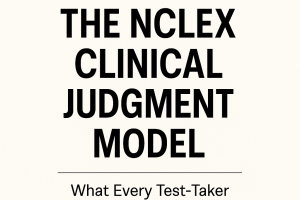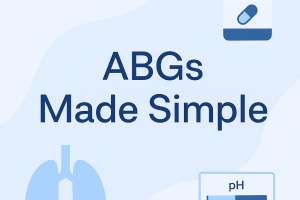Chest Tube Management for the NCLEX: What Every Nurse Should Know

Chest tube questions are a favorite on the NCLEX because they test both your clinical judgment and your ability to respond to emergencies. Whether the patient has a pneumothorax, hemothorax, or pleural effusion, chest tube care is critical—and so is your understanding of what’s normal, what’s not, and when to act fast.
In this post, we’ll break it all down so you can walk into your exam with confidence.
What Is a Chest Tube and Why Is It Used?
A chest tube is a flexible plastic tube inserted through the chest wall and into the pleural space to:
- Remove air (pneumothorax)
- Remove fluid or blood (pleural effusion or hemothorax)
- Re-expand a collapsed lung
It connects to a drainage system that allows air or fluid to leave the body but prevents it from coming back in.
The NCLEX Loves These 3 Chest Tube Scenarios
1. Pneumothorax (Air)
- Chest tube removes trapped air so the lung can re-expand.
- Expect bubbling in the water seal chamber initially.
- Intervention focus: Monitor for air leaks, breath sounds, and signs of respiratory distress.
2. Hemothorax or Pleural Effusion (Blood or Fluid)
- Chest tube drains excess fluid or blood.
- Bubbling is not expected in the water seal chamber.
- Intervention focus: Measure drainage, monitor for hypotension or hypovolemia.
3. Post-Op Chest Surgery
- Used preventatively to remove residual air or blood.
- Monitor drainage amount and character.
How the Chest Drainage System Works
There are typically three chambers in a chest tube system:
- Drainage Chamber – Collects air, fluid, or blood.
- Water Seal Chamber – Acts as a one-way valve to prevent backflow.
- Suction Control Chamber – Regulates negative pressure with wall suction or water.
Key NCLEX Rules: What’s Normal vs. Abnormal?
| Assessment Finding | Normal or Not? | What to Do |
|---|---|---|
| Gentle bubbling in water seal (pneumothorax) | Normal early on | Monitor |
| Continuous bubbling in water seal | Abnormal (air leak) | Check tubing, notify provider |
| Tidaling (fluid rises/falls with breathing) | Normal | Monitor, should stop when lung re-expands |
| Sudden cessation of tidaling | Could be normal OR blocked tube | Check for kinks or clots |
| Output >100 mL/hr of bright red blood | Abnormal | Report to provider immediately |
| Chest tube becomes dislodged | Emergency | Cover with sterile dressing, call provider |
| System is knocked over | Abnormal | Set it upright and assess patient |
Chest Tube Nursing Priorities
- Keep the drainage system below chest level.
- Encourage deep breathing and coughing.
- Assess for subcutaneous emphysema (air under the skin—feels like Rice Krispies).
- Check for kinks or dependent loops in tubing.
- Never clamp the chest tube unless ordered.
- Always have emergency supplies ready:
- Sterile gauze
- Sterile water
- Occlusive dressing
- Kelly clamps (for provider use only)
Top NCLEX Questions Might Ask:
- What do you do if the chest tube gets pulled out?
- What’s the first nursing action if there’s no bubbling or tidaling?
- What assessment finding requires immediate provider notification?
- Which chamber should you expect bubbling in during a pneumothorax?
- When do you suspect an air leak?
Final Takeaway
Chest tube management can feel overwhelming, but once you understand the drainage system and recognize what’s expected vs. what’s dangerous, it becomes straightforward.
Focus your NCLEX prep on:
- What’s normal vs. abnormal
- When to intervene immediately
- What to report vs. monitor
Remember: as the nurse, your goal is to keep the patient stable and act quickly if complications arise. Master these skills now—and you’ll be more than ready on exam day.






